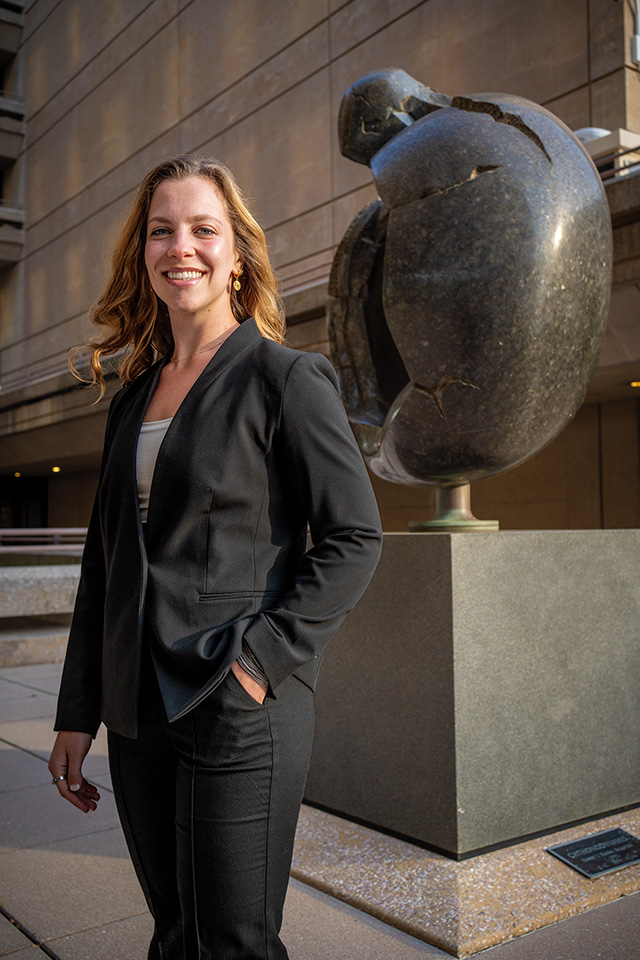Through two fellowships, historian Anna Pluff ’20 hopes to contribute to the conversation about reducing nuclear threats.

When the acclaimed biopic Oppenheimer came out last summer, some viewers were surprised to see how the “father of the atomic bomb” later warned against moral implications of the nuclear arms race. But not Anna Pluff ’20. As part of the inaugural cohort for the New Voices on Nuclear Weapons Fellowship, launched by the Federation of American Scientists, Pluff has been delving into archives to research the views of Manhattan Project scientists on nuclear weapons. “Many of them are some of the most eccentrically brilliant scientists you could study,” Pluff says. “And they cared very deeply about the implications of [their] work.”
In fact, after the atomic bomb was first tested in 1945, many of these scientists became politically active, advocating for nuclear “one worldism,” Pluff says. “They essentially thought the best way to protect the world moving forward was to form a world government that would have the sole authority over nuclear weapons.” While that idea might seem naïve in a post- Cold War world, Pluff says the scientists garnered support from many politicians and policymakers at the time and influenced later attempts to regulate nuclear weapons. “It’s not just about a movement that ultimately failed,” Pluff says. “By looking at these early nuclear-era solutions, we can also begin to conceptualize new imagined futures.”
Pluff has been imagining the future of nuclear weapons through not one but two fellowships — she is also pursuing a graduate fellowship through the National Nuclear Security Administration (NNSA), the government agency in charge of nuclear security and stockpile management. In that role, she is getting a hands-on look at how the government ships and stores nuclear waste and how it is modernizing its nuclear weapons stockpile. While Pluff is hesitant to advocate for increased nuclear weapons buildup, the fellowship has helped her better understand competing issues around maintaining the nation’s nuclear deterrent and how to keep us all safe.
She first grew to love history in Syracuse, N.Y., where she was inspired by her high school teacher, Thomas Bennett ’72. On the very first day of her AP History class, he asked students to list triumphs and tragedies in American history. “Without being cynical, there were a lot more tragedies than triumphs,” she says. “It made me think, the whole point of studying the past is not necessarily to inspire and create this perfect blueprint for the future, it’s also to put things in perspective and better understand humanity and why we do the things we do.”
Bennett encouraged her to apply to Colgate, specifically to the London History Study Group, where she dove into studying A.K. Chesterton, a controversial British neofascist after World War II. Though historians have often labeled Chesterton as a fascist, Pluff wanted to delve into the nuances of his political evolution. The program gave her the opportunity to spend hours in the archives with original sources, trying to better understand what caused Chesterton to engage with extremist ideology. “Especially as we see the rise of extremists today in places like Hungary and even the United States,” Pluff says, “we need to know what fascism looks like in practice and how we define it, rather than just using it as a blanket term over everything. Doing so allows us to mitigate these dangers moving forward more effectively.”
Inspired by a Colgate history class on Borderlands of North America with Professor Ryan Hall, she continued to study history in grad school at the University of Chicago, looking at how a coalition of Lakota activists, anti-nuclear activists, and white ranchers were able to defeat uranium mining in the Black Hills of South Dakota in the 1980s. “It was awesome to see how environmental issues in these nuclear borderlands could create a cultural understanding and ultimately this multiethnic alliance,” she says.
It was another Colgate class, the Advent of the Atomic Bomb with Professor Karen Harpp (earth and environmental geoscience, peace and conflict studies), that got her obsessed with the scientists behind the creation of nuclear weapons. “It just opened up a whole can of worms in the questions I wanted to study,” she says.
The questions have only become more urgent recently with Russia’s invasion of Ukraine once again putting the issue of nuclear weapons into the spotlight. Pluff is hoping that by looking at both current realities of the issue and past ideas on how to better manage it, she can meaningfully contribute to the conversation about reducing nuclear threats in the future. “I am motivated by the idea that we have a responsibility through creating this weapon to protect people — especially communities that are not often heard or protected,” she says. “It’s exciting for me to publish research with a historical angle into policymaking today.”
